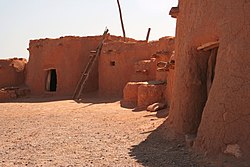
The Virgin Anasazi were the westernmost Ancestral Puebloan group in the American Southwest. They occupied the area in and around the Virgin River and Muddy Rivers, the western Colorado Plateau, the Moapa Valley and were bordered to the south by the Colorado River. [1] They occupied areas in present-day Nevada, Arizona, and Utah. Their occupation of the area lasted from about 1 CE to around 1200 CE, which according to the Pecos Classification places the occupation from Early Basketmaker II Era to Early Pueblo III periods. [1] Their neighbors were the Fremont culture to the north and the Kayenta Anasazi to the east.
Contents
- Regional Distribution
- Plateau
- St. George Basin
- Lowland Virgin
- Lifeways
- References
- See also
- External links
There is some contemporary controversy over the term 'Anasazi' (which early U.S. archaeologists borrowed from the Navajo word for 'ancient enemies'), and many contemporary descendants call them 'Ancestral Puebloan' or similar terms instead. [2]